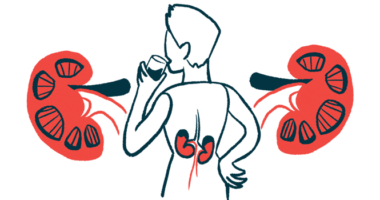Rare CFB Mutation Leads to aHUS Diagnosis, With Sepsis as Likely Trigger

Genetic testing identified a rare mutation in the complement factor B (CFB) gene that, together with an array of laboratory tests, led to a man being diagnosed with atypical hemolytic uremic syndrome (aHUS).
While the CFB mutation left the man genetically predisposed to aHUS, the doctor at Baton Rouge Medical Center in Louisiana who detailed the man’s case suspects that symptom onset was likely spurred by an infection contracted in the hospital.
Thorough testing allowed doctors to distinguish aHUS from other forms of thrombotic microangiopathy (TMA), the internist noted, adding that while “the diagnosis of atypical HUS is very challenging,” it is critical for appropriate treatment.
The case report, “Atypical Hemolytic Uremic Syndrome Caused by a Rare Complement Factor B Mutation,” was published in the journal Cureus.
TMA is broadly characterized by the formation of clots in the small blood vessels of the body. aHUS is a form of TMA caused by dysregulation of the complement system, a part of the immune system.
Diagnosing aHUS can be difficult, particularly because of its many similarities to other forms of TMA, including those caused by Shiga-toxin producing E.coli (STEC-HUS) and thrombotic thrombocytopenic purpura (TTP).
In this case, the 54-year-old man arrived at the hospital with a rib fracture and a history of heart disease and high blood pressure. A physical exam revealed a fast heart rate, chest tenderness, breathing abnormalities, and pale skin.
While in the hospital, he developed sepsis — the body’s severe response to infection — resulting from a case of pneumonia. Soon after, he was found to have elevated creatinine levels, indicating that the kidneys are failing to properly clear waste products from the blood. He underwent dialysis to clean his blood.
Subsequent laboratory analyses showed the man had the three cardinal symptoms of aHUS and other TMA types: hemolytic anemia, thrombocytopenia or low platelet counts, and acute kidney failure.
Hemolytic anemia is a condition in which red blood cells are destroyed faster than they can be produced, leading to insufficient oxygen being delivered to tissues.
In this man, the condition was evidenced by low levels of hemoglobin — the oxygen-carrying protein in red blood cells, haptoglobin, which regulates hemoglobin, and elevated lactate dehydrogenase, a marker of tissue damage. Schistocytes — red blood cell fragments that are characteristic of hemolytic anemia — were also present.
Thrombocytopenia was also evident in the blood tests. His creatinine levels continued to be elevated, and the man ultimately developed acute kidney failure, requiring intermittent dialysis.
Given his TMA symptoms, additional tests were performed to determine the disease’s underlying cause.
Levels of the ADAMTS13 enzyme, which are known to be low in TTP but are normal in STEC-HUS and aHUS, were normal. A Shiga-toxin test was negative, ruling out STEC-HUS. Additional blood tests ruled out other secondary causes, such as autoimmune disorders.
A kidney biopsy showed signs of kidney damage and deposits of complement component C3 — the complement pathway’s most abundant protein, and one of its most important proteins. Further, blood levels of C3 were abnormally low.
A genetic test identified a mutation in the CFB gene, which is involved in activating C3 and the complement pathway. Of note, CFB mutations and C3 involvement are a relatively rare cause of aHUS.
“These findings suggested disruption in the regulation of the complement pathway and supported a compatible etiology [disease origin] for atypical HUS,” the doctor wrote.
While genetics are often the underlying cause of aHUS, many patients require a “second hit,” such as an infection, to spur disease symptoms. In this man’s case, that second hit could have been the sepsis that followed him developing pneumonia.
After his diagnosis, the man was scheduled to receive Soliris (eculizumab), an approved antibody-based therapy marketed by Alexion that is designed to block the overactivation of the complement system in people with aHUS.
“This case highlights the importance of not overlooking rare causes of TMAs because the diagnostic evaluation is important for guiding appropriate management and obtaining a favorable prognosis,” the report concluded.







